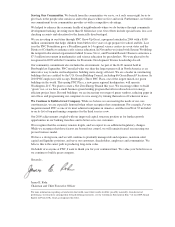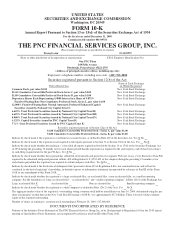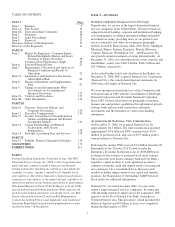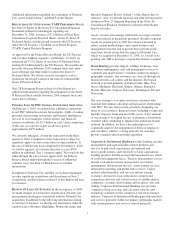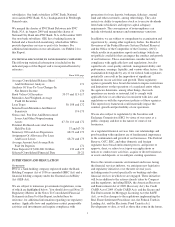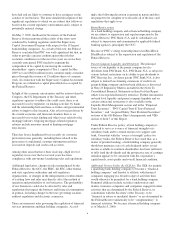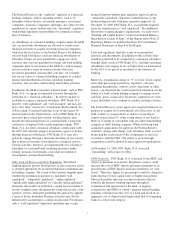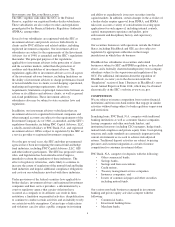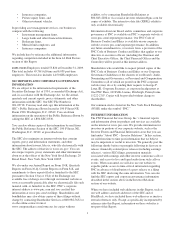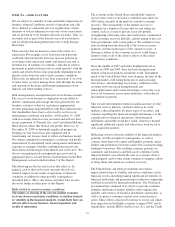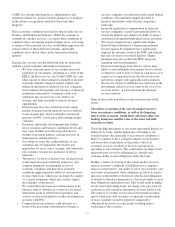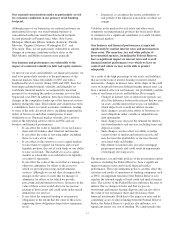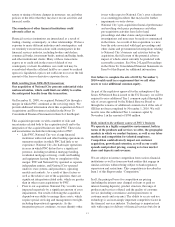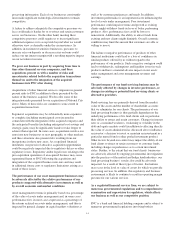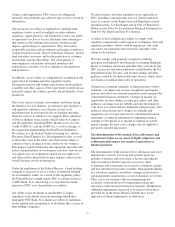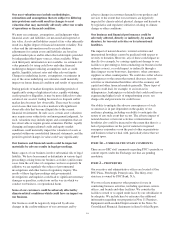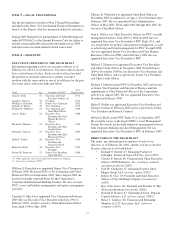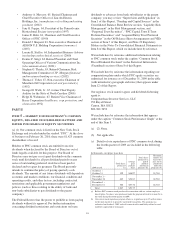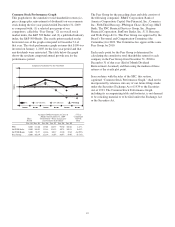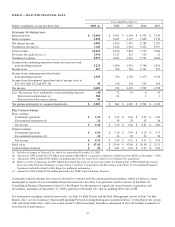PNC Bank 2009 Annual Report Download - page 14
Download and view the complete annual report
Please find page 14 of the 2009 PNC Bank annual report below. You can navigate through the pages in the report by either clicking on the pages listed below, or by using the keyword search tool below to find specific information within the annual report.
ITEM
1
A
–
RISK FACTORS
We are subject to a number of risks potentially impacting our
business, financial condition, results of operations and cash
flows. Indeed, as a financial services organization, certain
elements of risk are inherent in every one of our transactions
and are present in every business decision we make. Thus, we
encounter risk as part of the normal course of our business,
and we design risk management processes to help manage
these risks.
There are risks that are known to exist at the outset of a
transaction. For example, every loan transaction presents
credit risk (the risk that the borrower may not perform in
accordance with contractual terms) and interest rate risk (a
potential loss in earnings or economic value due to adverse
movement in market interest rates or credit spreads), with the
nature and extent of these risks principally depending on the
identity of the borrower and overall economic conditions.
These risks are inherent in every loan transaction; if we wish
to make loans, we must manage these risks through the terms
and structure of the loans and through management of our
deposits and other funding sources.
Risk management is an important part of our business model.
The success of our business is dependent on our ability to
identify, understand and manage the risks presented by our
business activities so that we can balance appropriately
revenue generation and profitability with these inherent risks.
Our shareholders have been well served by our focus on
maintaining a moderate risk profile. At December 31, 2008
with an economy then in severe recession and with our then
recent acquisition of National City, our Consolidated Balance
Sheet did not reflect that desired risk profile. However, by
December 31, 2009 we had made significant progress in
bringing our risk issues back into alignment and in
transitioning our balance sheet to reflect our business model.
We remain committed to returning to a moderate risk profile
characterized by disciplined credit management and limited
exposure to earnings volatility resulting from interest rate
fluctuations and the shape of the interest rate yield curve. We
discuss our principal risk management processes and, in
appropriate places, related historical performance in the Risk
Management section included in Item 7 of this Report.
The following are the key risk factors that affect us. In
general, each of these risk factors presents the risk of a
material impact on our results of operations or financial
condition, in addition to other possible consequences
described below. These risk factors and other risks are also
discussed further in other parts of this Report.
Risks related to current economic conditions
The failure or slowing of the current modest economic
recovery from recessionary conditions, or further turmoil
or volatility in the financial markets, would likely have an
adverse effect on our business, financial position and
results of operations.
The economy in the United States and globally began to
recover from severe recessionary conditions near mid-year
2009 and is currently in the midst of a modest economic
recovery. The sustainability of the modest recovery is
dependent on a number of factors that are not within our
control, such as a return to private sector job growth,
strengthening of housing sales and construction, continuation
of the economic recovery globally, and the timing of the exit
from government credit easing policies. We continue to face
risks resulting from the aftermath of the severe recession
generally and the modest pace of the current recovery. A
slowing or failure of the economic recovery could bring a
return to some or all of the adverse effects of the earlier
recessionary conditions.
Since the middle of 2007 and with a heightened level of
activity in 2008 and 2009, there has been disruption and
turmoil in financial markets around the world. Throughout
much of the United States there were dramatic declines in the
housing market, with falling home prices and increasing
foreclosures, and deepening recessionary conditions in the
economy led to increased unemployment and
underemployment and to reduced earnings, or in some cases
losses, for businesses across many industries, with reduced
investments in growth.
This overall environment resulted in significant stress for the
financial services industry, and led to distress in credit
markets, reduced liquidity for many types of securities, and
concerns regarding the financial strength and adequacy of the
capitalization of financial institutions. Some financial
institutions around the world have failed, some have needed
significant additional capital, and others have been forced to
seek acquisition partners.
Reflecting concern about the stability of the financial markets
generally and the strength of counterparties, as well as
concern about their own capital and liquidity positions, many
lenders and institutional investors reduced or ceased providing
funding to borrowers. The resulting economic pressure on
consumers and businesses and the lack of confidence in the
financial markets exacerbated the state of economic distress
and hampered, and to some extent continues to hamper, efforts
to bring about and sustain an economic recovery.
The United States and other governments have taken
unprecedented steps to stabilize and restore confidence in the
financial system, including making significant investments in
financial institutions and guaranteeing or otherwise supporting
troubled assets held by financial institutions. The US federal
government has continued in its efforts to provide economic
stimulus and financial market stability and to enhance the
liquidity and solvency of financial institutions and markets, as
well as to protect consumers and investors from financial
abuse. These efforts, which will continue to evolve and which
have impacted and will likely continue to impact PNC and its
stakeholders, include EESA, the Recovery Act, and the Credit
10


